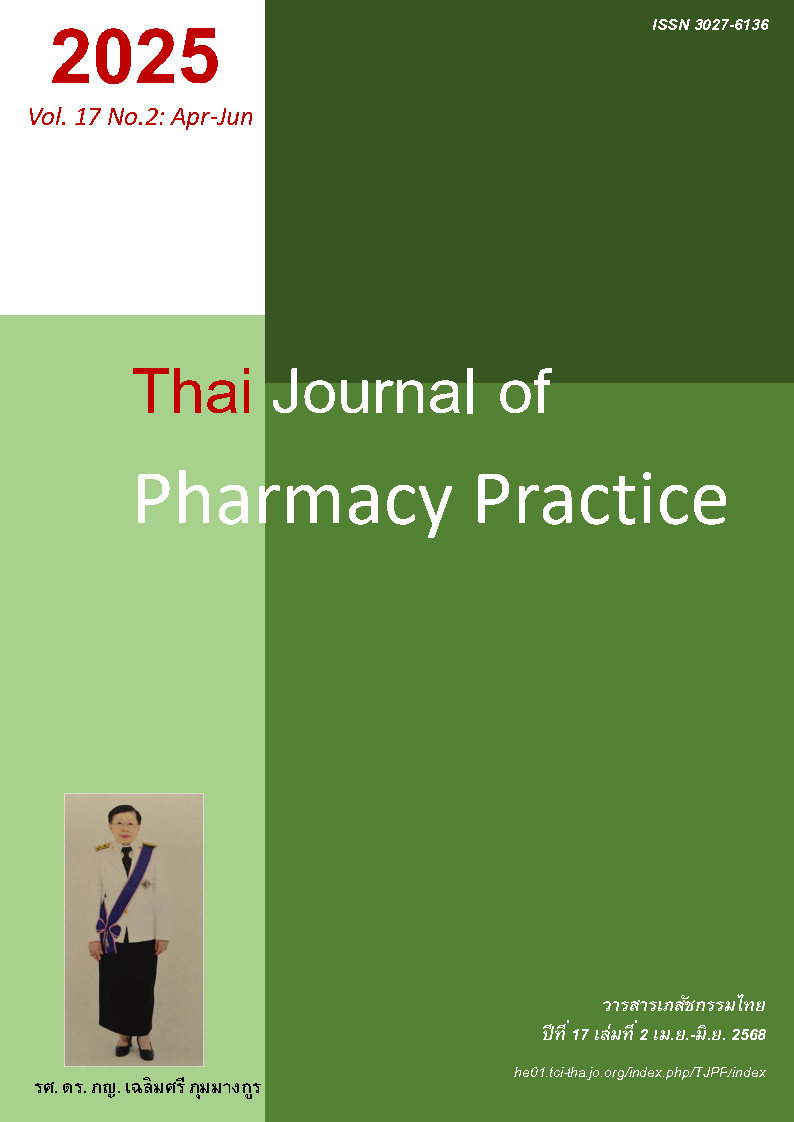การออกแบบวิธีการรักษาแบบเฉพาะสำหรับผู้ป่วยโรคเบาหวานที่ โรงพยาบาลเศรษฐาธิราช สาธารณรัฐประชาธิปไตยประชาชนลาว
Main Article Content
บทคัดย่อ
เพื่อออกแบบวิธีการรักษาแบบเฉพาะราย (tailor-made interventions: TMIs) ในผู้ป่วยโรคเบาหวานของโรงพยาบาลเศรษฐาธิราชในประเทศสาธารณรัฐประชาธิปไตยประชาชนลาว (สปป ลาว) วิธีการ: การศึกษานี้ดำเนินการที่คลินิกเบาหวาน โรงพยาบาลเศรษฐาธิราช สปป.ลาว การศึกษาแบ่งเป็น 2 ระยะ ระยะที่ 1 เป็นการศึกษาเชิงพรรณนาภาคตัดขวางในผู้ป่วยอายุ 45 ปี ขึ้นไปที่เป็นโรคเบาหวานประเภท 2 โดยอาจมีโรคความดันโลหิตสูงร่วมด้วยหรือไม่ก็ได้ มีค่า HbA1c ตั้งแต่ 7% ขึ้นไปและระดับน้ำตาลในเลือดมากกว่า 130 mg/dL ความรู้เรื่องโรคเบาหวานและวิธีการจัดการของผู้ป่วยวัดด้วยแบบวัด Diabetes Knowledge Questionnaires (DKQ) จำนวน 24 ข้อ แบบวัด Brief Medication Questionnaires (BMQ) ใช้เพื่อประเมินความร่วมมือในการใช้ยาของผู้ป่วย การค้นหาและการจัดประเภทปัญหาการใช้ยา (drug-related problems: DRPs) ใช้เกณฑ์ของ Pharmaceutical Care Network Europe working group (PCNE Version 9.1, 2020) การศึกษาระยะที่ 2 เป็นการสัมภาษณ์แบบกลุ่มระหว่างทีมบุคลากรทางการแพทย์ที่ทำงานในคลินิกเบาหวาน โรงพยาบาลเศรษฐาธิราช โดยอาศัยข้อมูลจากวิจัยระยะที่ 1 การสัมภาษณ์เป็นการระดมสมองและออกแบบ TMIs ที่เหมาะสมกับการปฏิบัติงาน ผลการวิจัย: ผู้ป่วยเข้าร่วมการศึกษา 110 คน ส่วนใหญ่เป็นผู้หญิง (ร้อยละ 59.1) อายุเฉลี่ย 56.00±9.20 ปี ระดับน้ำตาลในเลือดขณะอดอาหารเฉลี่ยอยู่ที่ 185 ± 65.31 mg/dLและ HbA1c เฉลี่ย คือ ร้อยละ 9.26±1.94 ตัวอย่างส่วนใหญ่ (86 รายหรือร้อยละ 78.18) มีคะแนนเมื่อประเมินด้วยแบบวัด DKQ อยู่ระหว่าง 9 to 18 จากคะแนนเต็ม 24 ผู้ป่วยร้อยละ 40 ไม่ร่วมมือในการใช้ยาเมื่อประเมินด้วย BMQ ประเภทของ DRP ที่พบบ่อยที่สุด คือ “P1.1 ไม่มีผลของการรักษาด้วยยา” (ร้อยละ 85 ของผู้ป่วย) การศึกษาในระยะที่ 2 พบ 3 ประเด็นที่เกี่ยวข้องกับการพัฒนา TMIs คือ มุมมองด้านการให้บริการปัจจุบัน มุมมองเกี่ยวกับอุปสรรคภายในองค์กรต่อการให้บริการผู้ป่วย และบทบาทของบุคลากรทางการแพทย์ใน TMIs ทั้งนี้ มีข้อเสนอแนะให้ใช้เครื่องมือในการประเมินและให้ความรู้ ตลอดจนข้อเสนอต่อบทบาทของเภสัชกรใน TMIs ร่วมกับแพทย์และพยาบาลในการดูแลผู้ป่วยที่พบ DRPs และมีผลการรักษาที่ไม่ดี สรุป: ทีมบุคลาการทางการแพทย์เห็นพ้องกันถึงความสำคัญของ TMIs ในการดูแลผู้ป่วยเบาหวานที่มีปัญหาการไม่ใช้ยาตามสั่งและมีผลลัพธ์การรักษาไม่ดี รูปแบบการให้บริการนี้น่าจะช่วยเพิ่มมาตรฐานการดูแลผู้ป่วย และยังช่วยให้ผลลัพธ์ด้านสุขภาพของผู้ป่วยดียิ่งขึ้น
Article Details

This work is licensed under a Creative Commons Attribution-NonCommercial-NoDerivatives 4.0 International License.
ผลการวิจัยและความคิดเห็นที่ปรากฏในบทความถือเป็นความคิดเห็นและอยู่ในความรับผิดชอบของผู้นิพนธ์ มิใช่ความเห็นหรือความรับผิดชอบของกองบรรณาธิการ หรือคณะเภสัชศาสตร์ มหาวิทยาลัยสงขลานครินทร์ ทั้งนี้ไม่รวมความผิดพลาดอันเกิดจากการพิมพ์ บทความที่ได้รับการเผยแพร่โดยวารสารเภสัชกรรมไทยถือเป็นสิทธิ์ของวารสารฯ
References
Saeedi P, Peterson I, Salpea P, Malanda B, Karuranga S, Unwin N, et al. Global and regional diabetes prevalence estimates for 2019 and projections for 2030 and 2045: Results from the International Diabetes Federation Diabetes Atlas, 9th edition. Diabetes Res Clin Pract 2019; 157: 107843.
Moreau M, Gagnon MP, Boudreau F. Development of a fully automated, web-based, tailored intervention promoting regular physical activity among insufficiently active adults with type 2 diabetes: integrating the I-change model, self-determination theory, and motivational interviewing components. J Med Internet Res 2015; 4: e25.
Zhao PX, Chao W, Qin L, Yuan M, Xiao Q, Guo YH, et al. Effect of clinical pharmacist's pharmaceutical care intervention to control hypertensive outpatients in China. Afr J Pharm 2012; 6: 48-56.
Ryan K, Dockray S, Linehan C. A systematic review of tailored eHealth interventions for weight loss. Digit Health 2019; 5: 2055207619826685. doi: 10.1177/ 2055207619826685.
Baker R, Camosso-Stefinovic J, Gillies C, Shaw EJ, Cheater F, Flottorp S, et al. Tailored interventions to address determinants of practice. Cochrane Database of Systematic Reviews 2015; (4): CD00 5470.
Lustria MLA, Cortese J, Gerend M A, Schmitt K, Kung Y M, McLaughlin C. A model of tailoring effects: a randomized controlled trial examining the mechanisms of tailoring in a web-based STD screening intervention. Health Psychol 2016; 35: 1214-24.
Van der Laan DM, Elders PJM, Boons CCLM, Nijpels G, van Dijk L, Hugtenburg JG. Effectiveness of a patient-tailored, pharmacist-led intervention program to enhance compliance to antihypertensive medication: the CATI study. Front Pharmacol 2018; 26: 1057.
Griffith DM, Jaeger EC, Valdez LA, Schaefer Solle N, Garcia DO, Alexander LR. Developing a “tailor-made” precision lifestyle medicine intervention for weight control among middle-aged Latino men. Ethn Dis 2020; 30(Suppl1): 203-10.
Bains SS, Egede LE. Associations between health literacy, diabetes knowledge, self-care behaviors, and glycemic control in a lowincome population with type 2 diabetes. Diabetes Technol Ther 2011; 13: 335-41.
Tol A, Sharifirad G, Shojaeezadeh D, Alhani F, Eslami A, Tehrani MM. Assessment of self-management behaviors in type 2 diabetes patients to develop tailor-made theory-based interventions. J Appl Environ Biol Sci 2011; 1: 572-5.
Garcia AA, Villagomez ET, Brown SA, Kouzekanani K, Hanis CL. The Starr County Diabetes Education Study: development of the Spanish-language diabetes knowledge questionnaire. Diabetes Care 2001; 24: 16-21.
Alfian SD, Abdulah R, Denig P, van Boven JFM, Hak E. Targeted and tailored pharmacist-led intervention to improve adherence to antihyper- tensive drugs among patients with type 2 diabetes in Indonesia: Study protocol of a cluster randomised controlled trial. BMJ Open 2020; 10: e034507.
Cochran WG. Sampling techniques. 3rd ed. New York: John Wiley & Sons; 1977
Wang J, Bian RW, Mo YZ. Validation of the Chinese version of the eight-item Morisky medication adherence scale in patients with type 2 diabetes mellitus. J Clin Gerontol Geriatr 2013; 4: 119-22.
Svarstad BL, Chewning BA, Sleath BL, Claesson C. The Brief Medication Questionnaire: a tool for screening patient adherence and barriers to adherence. Patient Educ Couns 1999; 37: 113-24. doi: 10.1016/s0738-3991(98)00107-4.

